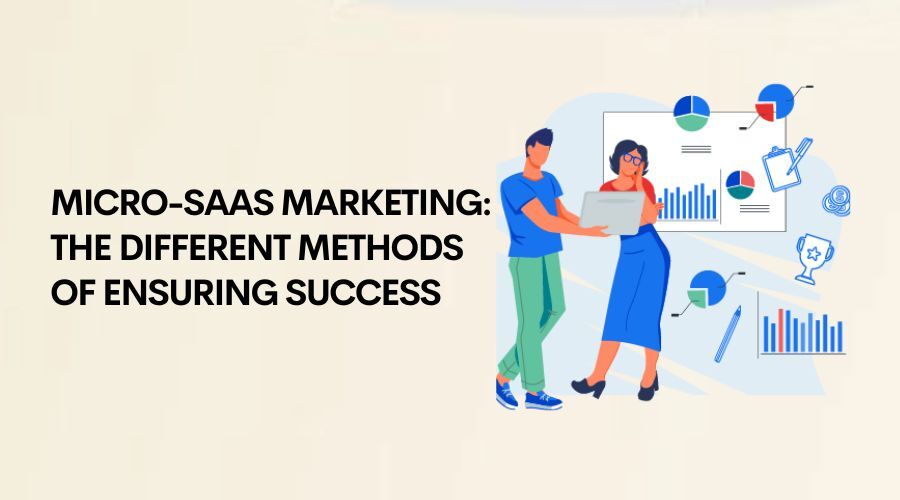You must learn how to do micro-SaaS marketing well if you want your product to succeed.
Because–let’s face it–your software product alone won’t be enough to encourage people to buy it.
Also, great micro-software as a service (SaaS) products are so common nowadays, it’s only a matter of time before your software gets usurped by the next big thing.
This is why you must devise a way to promote your product.
In this article, we will guide you on how to market your micro-SaaS the right way.
By the end of it, you should get your micro-SaaS product off the ground and running.
Let’s start.
5 Ways to Ensure Your Own Micro-SaaS Marketing Success

As micro-SaaS founders, there are various tactics to promote your product to people.
However, you don’t have to implement all of them. Choosing the right techniques to use for your marketing strategy is more than enough.
Not only will more of your target audience learn about and buy it; you can also set your micro-SaaS business firmly on the ground by building a dedicated user base.
This makes it more difficult for other micro-SaaS companies to knock you off from the top.
To get you started, below are the five best ways to market your micro-SaaS products:
1. Product Marketing

Product marketing refers to the entire process of bringing a product to market, promoting it, and selling it to paying customers.
It focuses on understanding who the product’s audience is and crafting a specific message that appeals to their needs.
To do this, you must put a narrow focus on brand positioning.
What this means is that you need to determine the product’s suitability in the market.
It’s also vital that you be familiar with similar competing software so that you’ll know how to differentiate your brand reputation from the rest.
Because of this, product marketing is where your organization’s marketing and sales teams coordinate.
Knowing how to market your software allows the sales team to understand the product better.
This enables them to sell your software to prospects more effectively.
A great product marketing example is Originality.AI.

It was launched around the time when ChatGPT was getting lots of press.
However, the AI generator posed lots of issues, one of them being the originality of the content it created.
To be fair, ChatGPT producing relatively good quality content is not necessarily a bad thing.
But the risk of people abusing the tool to create AI content at scale is more prevalent than ever.
In this case, Originality.AI helps users accurately detect if an AI tool created the text or not.
The software addresses the need of website owners to publish content written by humans, among other use cases.
How to Maximize Product Marketing for Your Own Micro-SaaS Business
Chalk Originality.AI’s success to luck—it was released a week before ChatGPT was.
But this doesn’t mean you have to be lucky all the time with your micro-SaaS journey.
Below are ways to leverage product marketing and turn most of your target audience into customers:
1. Engage with your audience
Answer questions people have about your product. Walk them through how to use your software properly using video if necessary.
2. Launch on ProductHunt
Submit your product on ProductHunt and similar sites (like IndieHacker and SaaS Hub) to engage with like-minded people about your product and accept feedback.
3. Provide updates
Implement the customer feedback you receive from your email list to update your product and meet demands.
Afterward, inform people about your changes via email or a news page on your site.
2. Social Media Marketing

With over 4.89 billion users worldwide, social media is a marketing channel you can’t ignore without repercussions.
Here, micro-SaaS businesses such as yours can identify your audience from different platforms and create targeted messages for each one.
You can do this by developing a social media calendar with posts that help educate and engage with your audience about your respective products.
Another way is by using paid ads to reach your target audience directly. You will need a budget to execute this. But if done correctly, this lets you fast-track your way to greater reach and more customers.
One example is Carrd.
A successful micro-SaaS tool, Carrd lets users build one-page sites from the platform (similar to link-in-bio tools).
It gained lots of traction on social media during the Black Lives Matter movement, albeit in a way not mentioned above.
A page created using Carrd serves as a resource to educate themselves regarding the issue.
They can also donate, join protests, and check out other relevant causes from the page.
By actually using the product to provide value to users, Carrd was able to promote its brand at the same time.
This may also be because the page’s URL includes the brand name.
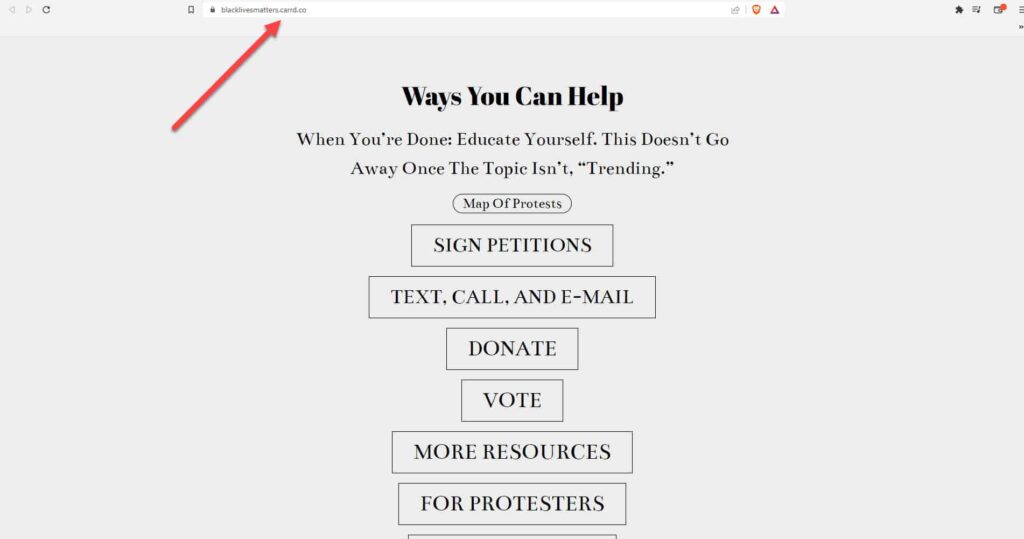
The page currently has over 367K and 79K shares on Twitter and Pinterest, respectively, according to Ahrefs.
Steps to Implement Social Media Marketing for Micro-SaaS
Card has the advantage of their tool to generate social media shares.
Then again, you can still leverage social media to make the most out of your micro-SaaS project.
Below are the steps you must take to the top of the micro-SaaS industry ladder.
1. Identify your platform
While you can use multiple social platforms simultaneously, don’t make the mistake of using all of them.
Determine the best channels to use (Facebook, Twitter, Instagram, TikTok) depending on your audience’s demographics.
2. Create platform-specific content
Facebook and Twitter allow you to post text, images, and videos. Instagram and TikTok mostly let you publish short videos and a caption on each.
YouTube, on the other hand, enables brands to upload long-form videos to engage with their audience.
3. Invest in tools
Aside from social schedulers, video editors, and image creators, you must use the best cameras and equipment to help record your videos to the highest quality possible.
The better the visuals, the more engagement they’ll get from your audience.
3. Search Engine Optimization

Search engine optimization (SEO) refers to ranking your website on search engine results pages (SERPs) for its target keywords.
Ranking on top of SERPs is important, considering that 68% of online experience starts with searching for something on Google.
SEO is divided into two: on-page and off-page optimization.
The former requires you to optimize your pages for their respective target keywords.
One way to do this is by including the keyword on the page’s URL, SEO title (which shows on search results), and H1.
The latter, also known as link building, is finding ways to secure an outbound link from an authoritative website to your site.
The goal is to create as many optimized pages and authoritative backlinks as possible.
If done right, more people will find your micro-SaaS idea and product from the very start.
Streamyard is one of the few micro-SaaS ideas that is getting lots of love from search engines.
According to Ahrefs, the site generates over 500k organic traffic a month.
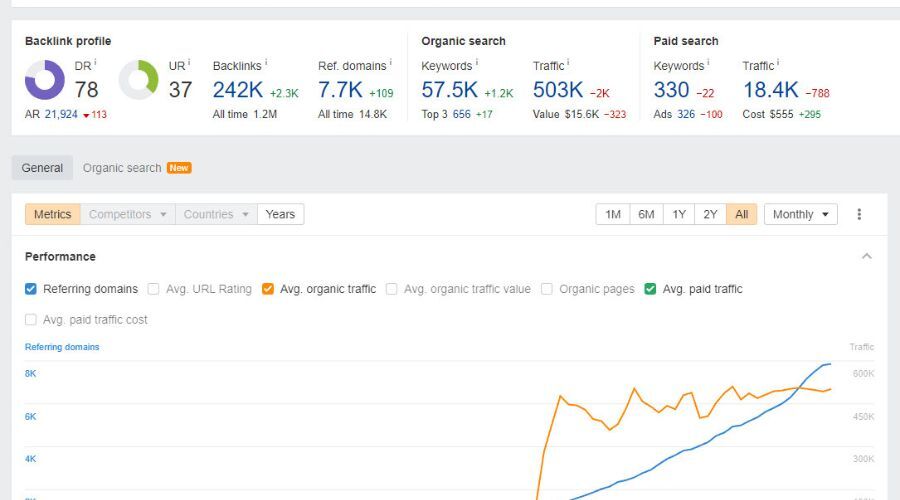
Looking at the graph, you can attribute its growth to the number of backlinks it has generated through the years.
Basic Micro-SaaS SEO Strategies to Adopt
Unlike most tactics here, SEO takes time before you can see the fruits of your marketing efforts.
It may take between 12-18 months before the results kick in. And this is assuming you did SEO by the book.
But the beauty of SEO is that your site will remain on SERPs once your site starts ranking. That means it will continue getting organic traffic over time, even while you sleep.
Below are strategies you can implement to turn this into reality:
1. Create linkable assets
The best link-building tactic is creating helpful content other sites want to link to.
Use the content as linkbait for your outreach campaign. You can also get it to rank on Google, attracting traffic from there naturally.
2. Avoid black hat SEO
Don’t be fooled by the quick rankings that black hat tactics promise—they are against Google guidelines.
While they may be able to rank your site in the first few weeks, Google will eventually penalize and de-rank your website from the SERPs.
3. Make sure Google can crawl your site
It’s possible that your site isn’t ranking on search results despite observing the best practices. If so, run a technical site audit on your website.
The results may uncover issues preventing search spiders from crawling and indexing your website.
4. Email Marketing

$40.
That’s how much you generally get from email marketing for every dollar you spend.
Live chat, messaging apps, and other communication tools provide businesses with a more direct way to engage with their audience.
However, email marketing remains the preferred method among audiences and businesses alike. And its impressive ROI reflects that.
A micro-SaaS business targeting huge swaths of people becomes more manageable using this marketing strategy.
This is because email marketing helps organizations collect emails from people interested in learning more about their micro-SaaS products.
From here, they can segment subscribers to receive automation emails using their tools of choice.
This enables businesses to create laser-focused messaging for various audience segments, thus increasing conversions.
For email marketing to be a worthy investment, however, you need to create an email sign-up form that people would want to join.
If you offer a free trial or freemium account of your micro-SaaS product, you can automatically include new prospects in your mailing list.
This is what many micro-SaaS software like Group.app did.
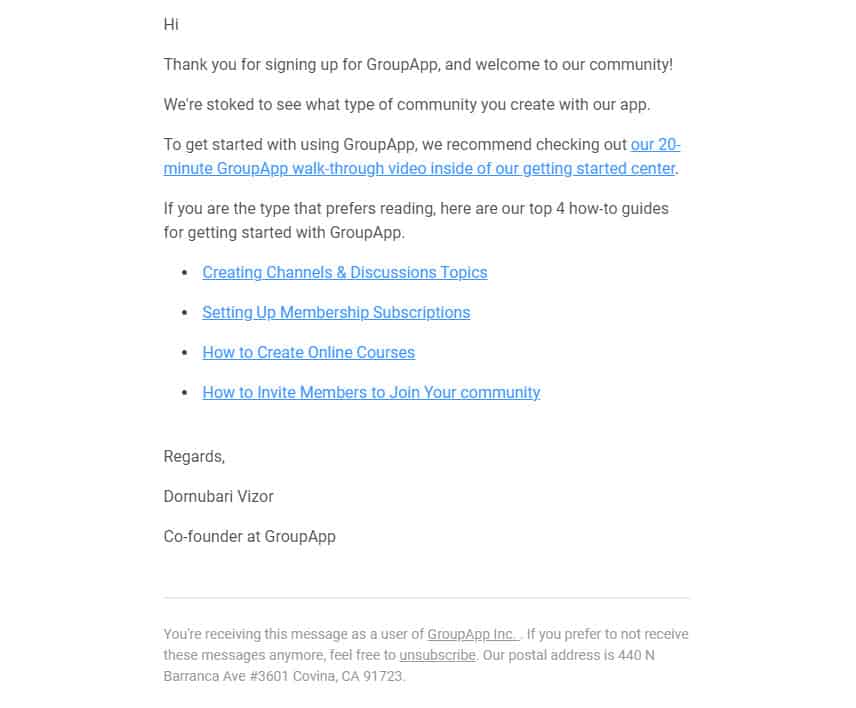
Tricks to Master Micro-SaaS Email Marketing
Below are ways you can use email marketing to promote your product to and engage with your audience:
1. Incentivize your opt-in forms
Offer free e-books, checklists, and other resources that provide value to your audience. You can make it so that they can only get these if they sign up for your list.
2. Leverage automation tools
Create drip campaigns to be sent on autopilot once subscribers sign up for your forms.
3. Review results
Check how your emails perform over time. If they have low open and conversion rates, improve the subject line and email content.
5. Content Marketing

Content marketing is a strategy aiming to educate your target audience about your micro-SaaS and lead them to buy your product via content.
That said, the strategies mentioned above can be subsets of content marketing.
For instance, social media posts, blog articles, and emails you send subscribers are forms of marketing your content.
But content marketing specifically focuses on structuring content pieces to engage with people in the various stages of your sales funnel.
Your content should engross people in the funnel’s awareness stage. Examples include promotional posts on social media and informational blog posts about how to use your product and why people should use your product.
On the other hand, content should captivate people in the decision stage too.
This is where you ask people to sign up for your product webinars and demos or set up product comparison and pricing pages on your site.
Dux-Soup, an automated lead generation micro-SaaS for LinkedIn, is an example that does content marketing right.
Its website has a Case Studies page that showcases how customers have used the tool to close more deals on LinkedIn.
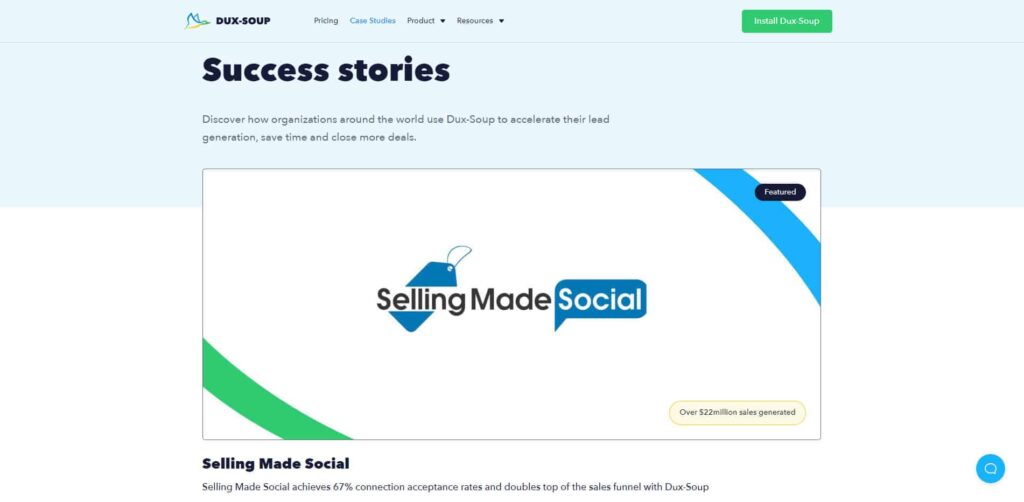
The page engages with prospects who like what Dux-Soup offers but are still deciding whether to buy it.
For people who want to know what the micros-SaaS tool is about, they can register for its upcoming webinar.
It provides a brief product introduction before delving into its use cases.
It also publishes articles about lead generation insights, product tips, and news.
Micro-SaaS Content Marketing Tips to Do on Your Own
Taking a cue from Dux-Soup, below are things you can do to boost your micro-SaaS’s content marketing strategy:
1. Coordinate all channels
Use your preferred channels and cross-promote content across different platforms for maximum engagement.
Here, you can promote your case studies and blog posts in your email and social media.
Conversely, you can also ask blog readers to subscribe to your email list and follow you on social media for more information.
2. Repurpose your content
Another way is to transform your content into different formats and distribute them to their appropriate channels.
For example, you can record the webinar as it happens and upload it on YouTube for additional views.
Subsequently, you can embed the video in your blog post and discuss it.
3. Optimize for SEO
When publishing website content, target a relevant keyword for each post and observe the best on-page SEO practices.
Final Thoughts on Micro-SaaS Marketing Success
Micro-SaaS marketing success requires you to use the best strategies that work for you.
But even if you have decided on the strategies to use, implementing them and tracking the results is another story altogether.
So if you’re looking for someone who can lend you a hand on this, we at Symalite Labs are here to help.
As a micro-SaaS studio, we can help bring your product into the market with our knowledge of product development and marketing.
Want to see what products we’ve helped market successfully?
GroupLeads and Chatsilo are what you’re looking for.
Send us a message if you’re interested in working with us, and we’ll get back to you in 24-48 hours.

